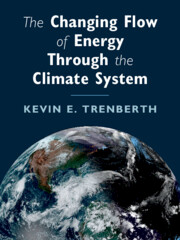Book contents
- The Changing Flow of Energy through the Climate System
- The Changing Flow of Energy through the Climate System
- Copyright page
- Contents
- Foreword
- Preface
- Acknowledgments
- 1 Earth and Climate System
- 2 Earth’s Energy Imbalance and Climate Change
- 3 Earth’s Energy Balance
- 4 The Sun–Earth System
- 5 Observations of Temperature, Moisture, Precipitation, and Radiation
- 6 The Climate System
- Flows of Energy
- 7 The Weather Machine
- 8 The Dynamic Ocean
- 9 Poleward Heat Transports by the Atmosphere and Ocean
- 10 The Changing Hydrological Cycle
- 11 Teleconnections and Patterns of Variability
- 12 El Niño
- 13 Feedbacks and Climate Sensitivity
- 14 Earth’s Energy Imbalance Estimates
- 15 Attribution and the Hiatus
- 16 Prediction and Projection
- 17 Emissions and Information
- 18 Climate Change and Environmental Issues
- Glossary
- Acronyms
- Bibliography
- Index
- References
9 - Poleward Heat Transports by the Atmosphere and Ocean
from Flows of Energy
Published online by Cambridge University Press: 25 February 2022
- The Changing Flow of Energy through the Climate System
- The Changing Flow of Energy through the Climate System
- Copyright page
- Contents
- Foreword
- Preface
- Acknowledgments
- 1 Earth and Climate System
- 2 Earth’s Energy Imbalance and Climate Change
- 3 Earth’s Energy Balance
- 4 The Sun–Earth System
- 5 Observations of Temperature, Moisture, Precipitation, and Radiation
- 6 The Climate System
- Flows of Energy
- 7 The Weather Machine
- 8 The Dynamic Ocean
- 9 Poleward Heat Transports by the Atmosphere and Ocean
- 10 The Changing Hydrological Cycle
- 11 Teleconnections and Patterns of Variability
- 12 El Niño
- 13 Feedbacks and Climate Sensitivity
- 14 Earth’s Energy Imbalance Estimates
- 15 Attribution and the Hiatus
- 16 Prediction and Projection
- 17 Emissions and Information
- 18 Climate Change and Environmental Issues
- Glossary
- Acronyms
- Bibliography
- Index
- References
Summary
As Earth rotates on its axis and revolves around the Sun, the basic geometry determines an excess of radiation from the Sun is received in the tropics, and there is a deficit in polar regions (Fig. 1.4). Contrasts in temperatures between the two regions would be far greater than observed (Chapter 5) were it not for the dynamic transport of energy polewards by the atmosphere and ocean. The contrast is greatest in winter, when the polar night sets in, with zero incoming radiation in the Arctic or Antarctic, and the contrast in summer is less in the northern versus southern hemisphere owing to the location of large continental land masses in mid- to high latitudes that more readily warm up than the oceans do. How and where the poleward energy transports occur greatly affect local climates.
- Type
- Chapter
- Information
- The Changing Flow of Energy Through the Climate System , pp. 121 - 139Publisher: Cambridge University PressPrint publication year: 2022

